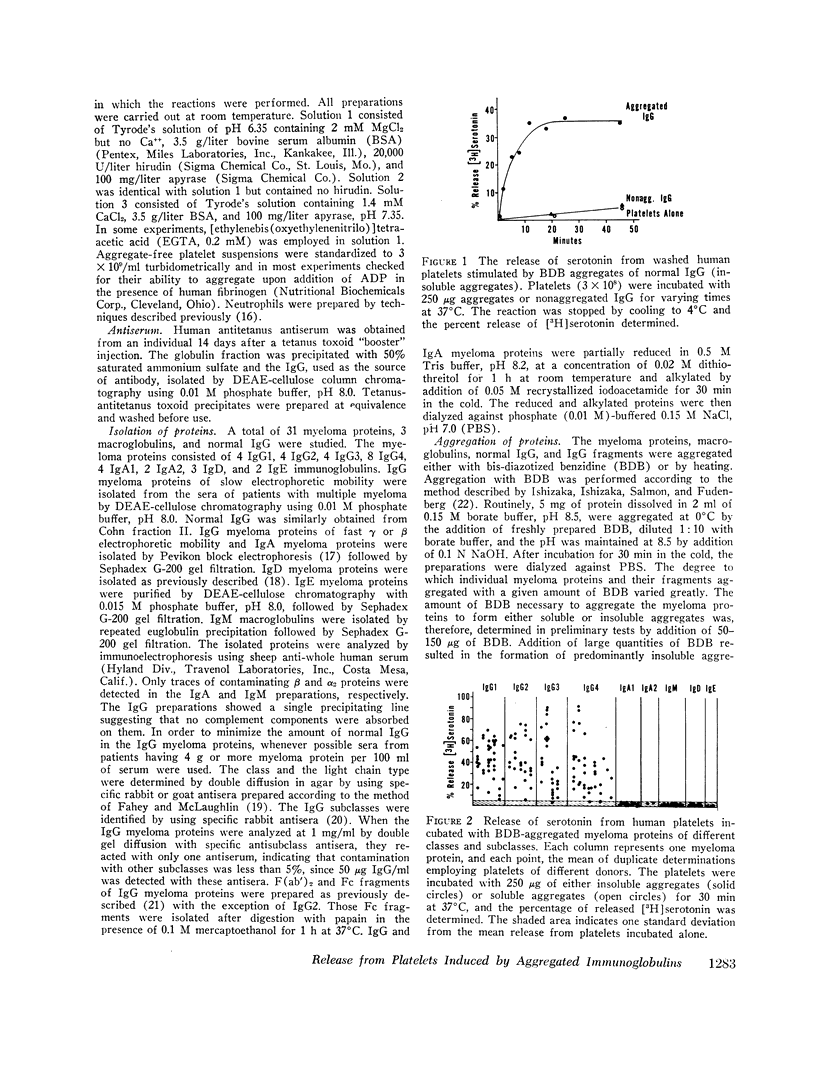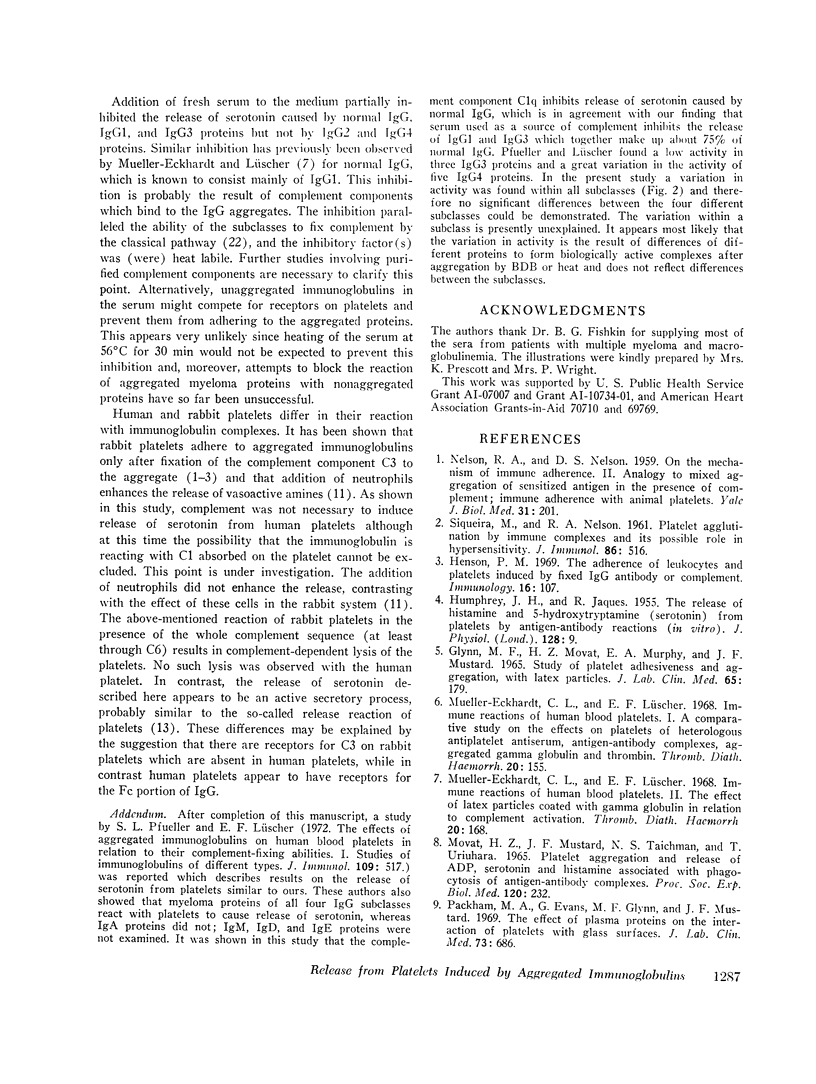Abstract
The ability of human myeloma proteins of different classes and subclasses and of macroglobulins (all aggregated with bis-diazotized benzidine or heat) to aggregate washed human platelets and release [3H]-serotonin from the platelets was investigated and compared with the activity of normal IgG and tetanus-antitetanus IgG antigen-antibody complexes. Aggregated IgG1, IgG2, IgG3, IgG4, and normal IgG complexes all aggregated platelets and caused release of serotonin to similar extents. In contrast, IgA1, IgA2, IgD, and IgE myeloma proteins as well as IgM macroglobulins were completely inactive in this respect. Approximately 50% of the actvity remained in aggregated, mildly reduced and alkylated IgG myeloma proteins and their Fc fragments, whereas aggregated F(ab′)2 fragments were completely inactive. Addition of fresh serum inhibited the release of serotonin caused by aggregated IgG1 and IgG3 proteins and normal IgG antigen-antibody complexes by about 50% but had no effect upon the release of serotonin obtained with IgG2 and IgG4 proteins. This inhibition appeared to be mediated by complement. The release of serotonin was not accompanied by liberation of the cytoplasmic enzyme lactic dehydrogenase, indicating that no significant lysis of the platelets occurred. Addition of neutrophils did not enhance the serotonin release.
Full text
PDF






Images in this article
Selected References
These references are in PubMed. This may not be the complete list of references from this article.
- ASTER R. H., JANDL J. H. PLATELET SEQUESTRATION IN MAN. I. METHODS. J Clin Invest. 1964 May;43:843–855. doi: 10.1172/JCI104970. [DOI] [PMC free article] [PubMed] [Google Scholar]
- FAHEY J. L., MCLAUGHLIN C. PREPARATION OF ANTISERA SPECIFIC FOR 6.6 S GAMMA-GLOBULINS, BETA 2A-GLOBULINS, GAMMA-1.-MACROGLOBULINS, AND FOR TYPE I AND II COMMON GAMMA-GLOBULIN DETERMINANTS. J Immunol. 1963 Oct;91:484–497. [PubMed] [Google Scholar]
- GLYNN M. F., MOVAT H. Z., MURPHY E. A., MUSTARD J. F. STUDY OF PLATELET ADHESIVENESS AND AGGREGATION, WITH LATEX PARTICLES. J Lab Clin Med. 1965 Feb;65:179–201. [PubMed] [Google Scholar]
- Henson P. M., Johnson H. B., Spiegelberg H. L. The release of granule enzymes from human neutrophils stimulated by aggregated immunoglobulins of different classes and subclasses. J Immunol. 1972 Dec;109(6):1182–1192. [PubMed] [Google Scholar]
- Henson P. M. Mechanisms of release of constituents from rabbit platelets by antigen-antibody complexes and complement. I. Lytic and nonlytic reactions. J Immunol. 1970 Aug;105(2):476–489. [PubMed] [Google Scholar]
- Henson P. M. Mechanisms of release of constituents from rabbit platelets by antigen-antibody complexes and complement. II. Interaction of platelets with neutrophils. J Immunol. 1970 Aug;105(2):490–501. [PubMed] [Google Scholar]
- Henson P. M. The adherence of leucocytes and platelets induced by fixed IgG antibody or complement. Immunology. 1969 Jan;16(1):107–121. [PMC free article] [PubMed] [Google Scholar]
- Henson P. M. The immunologic release of constituents from neutrophil leukocytes. I. The role of antibody and complement on nonphagocytosable surfaces or phagocytosable particles. J Immunol. 1971 Dec;107(6):1535–1546. [PubMed] [Google Scholar]
- Ishizaka T., Ishizaka K., Salmon S., Fudenberg H. Biologic activities of aggregated gamma-globulin. 8. Aggregated immunoglobulins of different classes. J Immunol. 1967 Jul;99(1):82–91. [PubMed] [Google Scholar]
- Kunkel H. G., Joslin F. G., Penn G. M., Natvig J. B. Genetic variants of G4 globulin. A unique relationship to other classes of G globulin. J Exp Med. 1970 Sep 1;132(3):508–520. doi: 10.1084/jem.132.3.508. [DOI] [PMC free article] [PubMed] [Google Scholar]
- MULLER-EBERHARD H. J. A new supporting medium for preparative electrophoresis. Scand J Clin Lab Invest. 1960;12:33–37. [PubMed] [Google Scholar]
- Movat H. Z., Mustard J. F., Taichman N. S., Uriuhara T. Platelet aggregation and release of ADP, serotonin and histamine associated with phagocytosis of antigen-antibody complexes. Proc Soc Exp Biol Med. 1965 Oct;120(1):232–237. doi: 10.3181/00379727-120-30496. [DOI] [PubMed] [Google Scholar]
- Mueller-Eckhardt C., Lüscher E. F. Immune reactions of human blood platelets. 3. Inhibition of immune reactions by sulfhydryl reagents. Thromb Diath Haemorrh. 1968 Dec 31;20(3):327–335. [PubMed] [Google Scholar]
- Mueller-Eckhardt C., Lüscher E. F. Immune reactions of human blood platelets. I. A comparative study on the effects on platelets of heterologous antiplatet antiserum, antigen-antibody complexes, aggregated gammaglobulin and thrombin. Thromb Diath Haemorrh. 1968 Nov 15;20(1):155–167. [PubMed] [Google Scholar]
- Mueller-Eckhardt C., Lüscher E. F. Immune reactions of human blood platelets. II. The effect of latex particles coated with gammaglobulin in relation of complement activation. Thromb Diath Haemorrh. 1968 Nov 15;20(1):168–179. [PubMed] [Google Scholar]
- Mustard J. F., Perry D. W., Ardlie N. G., Packham M. A. Preparation of suspensions of washed platelets from humans. Br J Haematol. 1972 Feb;22(2):193–204. doi: 10.1111/j.1365-2141.1972.tb08800.x. [DOI] [PubMed] [Google Scholar]
- NELSON R. A., Jr, NELSON D. S. On the mechanism of immune-adherence. II. Analogy to mixed aggregation of sensitized antigens in the presence of complement; immune-adherence with animal platelets. Yale J Biol Med. 1959 Feb;31(4):201–212. [PMC free article] [PubMed] [Google Scholar]
- Packham M. A., Evans G., Glynn M. F., Mustard J. F. The effect of plasma proteins on the interaction of platelets with glass surfaces. J Lab Clin Med. 1969 Apr;73(4):686–697. [PubMed] [Google Scholar]
- SPIEGELBERG H. L., WEIGLE W. O. THE CATABOLISM OF HOMOLOGOUS AND HETEROLOGOUS 7S GAMMA GLOBULIN FRAGMENTS. J Exp Med. 1965 Mar 1;121:323–338. doi: 10.1084/jem.121.3.323. [DOI] [PMC free article] [PubMed] [Google Scholar]
- Spiegelberg H. L., Fishkin B. G., Grey H. M. Catabolism of human gammaG-immunoglobulins of different heavy chain subclasses. I. Catabolism of gammaG-myeloma proteins in man. J Clin Invest. 1968 Oct;47(10):2323–2330. doi: 10.1172/JCI105917. [DOI] [PMC free article] [PubMed] [Google Scholar]
- Spiegelberg H. L., Prahl J. W., Grey H. M. Structural studies of human gamma D myeloma protein. Biochemistry. 1970 May 12;9(10):2115–2122. doi: 10.1021/bi00812a013. [DOI] [PubMed] [Google Scholar]
- Spiegelberg H. L., Weigle W. O. The production of antisera to human gammaGlobulin subclasses in rabbits using immunological unresponsiveness. J Immunol. 1968 Aug;101(2):377–380. [PubMed] [Google Scholar]



